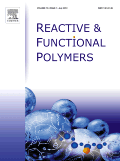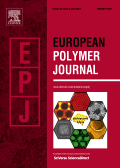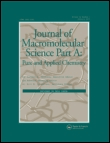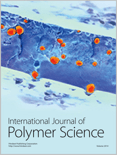
REACTIVE & FUNCTIONAL POLYMERS
Scope & Guideline
Advancing Polymer Science Through Innovation and Collaboration
Introduction
Aims and Scopes
- Polymer Synthesis and Characterization:
The journal frequently publishes research on novel polymerization techniques, including RAFT, UV-curing, and click chemistry. These studies often detail the synthesis of polymers with tailored properties for specific applications. - Functionalization and Modification of Polymers:
A significant focus is on the functionalization of existing polymer systems to enhance their properties. This includes the incorporation of nanoparticles, bioactive compounds, and other functional groups to impart new functionalities. - Biodegradable and Bio-based Polymers:
Research on environmentally friendly polymers, including bio-based and biodegradable materials, is prevalent. This includes studies on their synthesis, performance in various applications, and their degradation behavior in the environment. - Smart and Responsive Polymers:
The journal covers research on stimuli-responsive polymers that change properties in response to environmental stimuli such as pH, temperature, and light. This includes hydrogels and other materials with applications in drug delivery and sensors. - Polymer Composites and Nanocomposites:
There is a strong emphasis on the development of composite materials that combine polymers with inorganic materials, carbon nanomaterials, and other fillers to enhance mechanical, thermal, and barrier properties. - Applications in Biomedical Engineering:
Numerous studies explore polymer materials for biomedical applications, including drug delivery systems, tissue engineering scaffolds, and antimicrobial coatings. - Flame Retardant and Thermally Stable Polymers:
The journal frequently addresses the synthesis and characterization of flame-retardant polymers, particularly those that maintain thermal stability while exhibiting improved safety characteristics.
Trending and Emerging
- Sustainable and Green Polymer Solutions:
There is a notable increase in research focusing on sustainable and green polymers, including bio-based materials and those designed for recyclability and biodegradability. - Advanced Functionalization Techniques:
Emerging techniques for polymer functionalization, including the use of advanced catalysts and innovative chemical modifications, are gaining traction, leading to novel materials with enhanced properties. - Smart Materials and Responsive Systems:
Research on smart materials that respond to environmental stimuli continues to trend upward, particularly in applications for drug delivery systems and environmental sensors. - Integration of Nanotechnology:
The incorporation of nanotechnology into polymer matrices to develop nanocomposites with superior properties is increasingly common, reflecting a trend towards materials with enhanced mechanical and thermal performance. - Applications in Energy Storage and Conversion:
There is a growing focus on polymers in energy applications, including their use in batteries, supercapacitors, and fuel cells, highlighting their importance in the transition to renewable energy technologies.
Declining or Waning
- Traditional Polymer Processing Techniques:
There has been a noticeable decrease in papers focused on conventional polymer processing methods such as extrusion and molding, as newer, more innovative techniques gain popularity. - Low-performance Commodity Polymers:
Research on low-performance or commodity polymers has become less prominent, with a shift towards advanced materials that offer enhanced properties and functionalities. - Basic Polymer Chemistry:
Topics centered around basic polymer chemistry and fundamental studies without direct application or innovative aspects have waned, as the journal increasingly favors studies with practical implications. - Single-function Polymers:
There is a decline in the publication of studies focusing on polymers with single functionalities. The trend is moving towards multifunctional materials that can cater to multiple applications.
Similar Journals

EUROPEAN POLYMER JOURNAL
Innovating Materials Chemistry for a Sustainable FutureEUROPEAN POLYMER JOURNAL is a leading academic journal published by PERGAMON-ELSEVIER SCIENCE LTD, dedicated to advancing the field of polymer science and engineering. With a distinguished history since 1965, this journal serves as a critical platform for researchers to disseminate high-quality research findings within a broad scope that encompasses materials chemistry, organic chemistry, and physics. The journal boasts an impressive Q1 category ranking in multiple fields, including Materials Chemistry, Organic Chemistry, and Polymers and Plastics, placing it in the top tier of academic journals worldwide. Its standing is further reinforced by its high citation metrics, with ranks such as #16 in Organic Chemistry and #20 in Polymers and Plastics, reflecting its significant contribution to the advancement of knowledge and innovation in these areas. Although currently not available as an open-access journal, it provides subscribers with in-depth studies, reviews, and insights relevant to both academia and industry. Researchers, professionals, and students alike will find invaluable information and emerging trends in polymer research, making the EUROPEAN POLYMER JOURNAL an essential resource for staying at the forefront of this dynamic and evolving field.

PROGRESS IN POLYMER SCIENCE
Unveiling Breakthroughs in Materials ChemistryPROGRESS IN POLYMER SCIENCE is a prestigious academic journal published by PERGAMON-ELSEVIER SCIENCE LTD, dedicated to advancing the field of polymer science. With an ISSN of 0079-6700 and an E-ISSN of 1873-1619, this journal has established itself as a leading source of high-quality research since its inception in 1967. It ranks in the top quartile (Q1) across multiple categories including Ceramics and Composites, Materials Chemistry, Organic Chemistry, Polymers and Plastics, and Surfaces and Interfaces, reflecting its strong reputation and impact within the scientific community. The journal features rigorous peer-reviewed articles that not only contribute to theoretical advancements but also emphasize practical applications of polymer science in various industries. Although it is not an open-access journal, it remains accessible through institutional subscriptions and provides invaluable insights and data for researchers, professionals, and students alike. PROGRESS IN POLYMER SCIENCE is essential reading for anyone looking to stay abreast of the latest developments and innovations in this dynamic field.

JOURNAL OF POLYMER SCIENCE
Exploring the Science of Polymers: Where Innovation Meets ApplicationJOURNAL OF POLYMER SCIENCE, published by WILEY, is a premier, open-access journal dedicated to advancing the field of polymer science and its applications. With an ISSN of 2642-4150, it offers a platform for high-quality research and innovative ideas, contributing significantly to the understanding of polymaterials and their functionalities. The journal is recognized for its exceptional impact within various categories, consistently achieving Q1 rankings in Materials Chemistry, Physical and Theoretical Chemistry, and Polymers and Plastics, demonstrating its influential presence in the academic community. As of 2023, it holds a distinguished position in Scopus rankings, underscoring its relevance and rigorous peer-review process. By facilitating open access to vital research findings, the JOURNAL OF POLYMER SCIENCE plays a crucial role in fostering collaboration and knowledge transfer among researchers, professionals, and students, paving the way for innovative developments in polymer applications and materials science.

Journal of Macromolecular Science Part A-Pure and Applied Chemistry
Unlocking the Secrets of Macromolecular MaterialsWelcome to the Journal of Macromolecular Science Part A - Pure and Applied Chemistry, a distinguished publication dedicated to advancing the understanding of macromolecular science, encompassing critical areas such as polymers, materials chemistry, and composites. Published by Taylor & Francis Inc, this journal has firmly established its place within the scientific community, evident from its ranking in the Q2 and Q3 quartiles across various categories in the latest assessments, including Polymers and Plastics as well as Ceramics and Composites. With a commitment to providing high-quality peer-reviewed content, the journal aims to facilitate knowledge exchange and innovation among researchers and practitioners from around the globe. The absence of open access underscores the journal's commitment to maintaining rigorous editorial standards while remaining accessible to its readership. As the journal converges through valuable research contributions from 1992 to 2024, it continues to be a pivotal resource for professionals and students seeking to explore the latest advancements and applications in the field of macromolecular science.

International Journal of Polymer Science
Leading the Charge in Polymer Research ExcellenceInternational Journal of Polymer Science is a prominent and peer-reviewed journal dedicated to advancing the field of polymer science. Published by Hindawi Ltd, this open-access journal has been making significant contributions to the discipline since its inception in 2009, ensuring that research findings are accessible to a global audience. With an impressive impact factor and positioned in the Q2 quartile for Polymers and Plastics as of 2023, it ranks 46th out of 161 in the Scopus database, reflecting its strong standing in the research community. The journal welcomes innovative research across various topics within polymer science, including synthesis, characterization, and applications in diverse industries. By providing a platform for scholars, professionals, and students, the International Journal of Polymer Science not only encourages the dissemination of knowledge but also fosters collaboration and innovation in this essential field. Based in Egypt and operating under a rigorous selection process, it remains a vital resource for anyone involved in polymer research.

Express Polymer Letters
Fast-Tracking Discoveries in Polymer StudiesExpress Polymer Letters is a leading open-access journal published by BUDAPEST UNIVERSITY OF TECHNOLOGY AND ECONOMICS, focusing on the fast-paced realm of polymer science and engineering. With a broad scope that encompasses the interdisciplinary fields of Chemical Engineering, Materials Chemistry, and Organic Chemistry, the journal serves as a crucial platform for researchers and professionals dedicated to advancing knowledge and innovation in polymer-related disciplines. Since its inception in 2007, it has consistently provided high-quality, peer-reviewed research and has achieved a respectable impact within various categories, evidenced by its Q2 quartile rankings across multiple Scopus categories and its competitive standings in the field. The journal's dedication to open access ensures that research is widely disseminated, promoting transparency and collaboration within the academic community. Positioned to converge into the future, Express Polymer Letters remains an essential resource for cutting-edge studies and developments, with an anticipated convergence period extending through 2024.

JOURNAL OF POLYMER ENGINEERING
Empowering Research in Polymer Applications.JOURNAL OF POLYMER ENGINEERING, published by Walter de Gruyter GmbH, stands as a pivotal platform in the field of polymer science and engineering. With an ISSN of 0334-6447 and an E-ISSN of 2191-0340, this journal has been a vital contributor to the academic landscape since its inception, spanning publications from 1981 to 2024. As a recognized entity in the realms of Chemical Engineering, Materials Chemistry, and Polymers and Plastics, it holds a respectable position in Q3 quartile rankings according to the latest assessments. The journal is positioned to promote the exchange of cutting-edge research findings, technological advancements, and critical reviews that address the complexities of polymer application and innovation. Researchers and professionals will find a wealth of information, from experimental methodologies to theoretical analyses, all designed to inspire and elevate the current understanding of polymer engineering. By fostering collaboration and dissemination of knowledge, the JOURNAL OF POLYMER ENGINEERING remains crucial for advancing research and education in its specialized domains.

POLYMER INTERNATIONAL
Driving Excellence in Polymer ResearchPOLYMER INTERNATIONAL is a leading journal in the field of polymer science, published by Wiley, one of the most esteemed scholarly publishers. With an ISSN of 0959-8103 and an E-ISSN of 1097-0126, this journal has been a pivotal platform for researchers since its inception in 1991, now extending its coverage until 2024. The journal boasts a commendable standing in various scientific domains, achieving a Q2 quartile ranking in Materials Chemistry, Organic Chemistry, and Polymers and Plastics as of 2023. Additionally, it holds impressive Scopus ranks, including Rank #47 in Organic Chemistry and Rank #40 in Polymers and Plastics, placing it within the top percentiles of its categories. Researchers, professionals, and students alike can benefit from its rich array of articles that contribute to the understanding and advancement of polymer technology and materials science. Although not an open access journal, POLYMER INTERNATIONAL remains crucial for disseminating high-quality research that drives innovation and development within the field.

POLYMER
Exploring Innovations in Materials ChemistryPOLYMER, an esteemed journal published by Elsevier Science Ltd, stands at the forefront of polymer science, presenting cutting-edge research that encompasses the realms of Materials Chemistry, Organic Chemistry, and Polymers and Plastics. With a remarkable impact factor reflecting its significance in the academic community, POLYMER has been a vital resource since its inception in 1960, contributing to a converged body of knowledge through to 2024. Rated Q1 in all relevant categories as of 2023, and boasting impressive Scopus rankings, this journal not only facilitates advanced discussions in polymer synthesis, characterization, and applications but also serves as a critical platform for collaborative research among scholars, professionals, and students. While it offers content primarily via subscription, POLYMER remains dedicated to fostering innovation and excellence in the field, making it an essential read for anyone passionate about polymer science.

Polymer Reviews
Advancing the frontiers of polymer science.Polymer Reviews, published by Taylor & Francis Inc, is an esteemed journal dedicated to the intricate and evolving field of polymer science. With its ISSN 1558-3724 and E-ISSN 1558-3716, the journal has established a significant presence among researchers and practitioners alike, evidenced by its impressive categorization in the Q1 quartiles across multiple disciplines, including Biomedical Engineering, Materials Chemistry, and Renewable Energy. Since its inception in 2006 and continuing through 2024, Polymer Reviews has consistently aimed to advance the knowledge base of polymer applications and innovations, providing a platform for comprehensive review articles that stimulate further research and inspire practical solutions. The journal, ranking within the top percentile across several Scopus categories, underscores its impact and relevance in a rapidly developing scientific landscape. Though not an open-access journal, it remains a vital resource for those invested in the future of materials science and engineering.